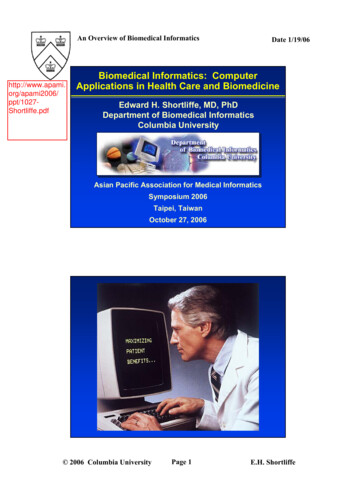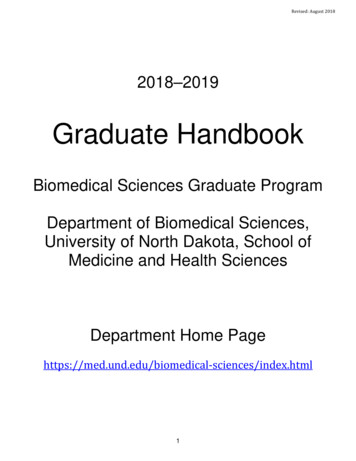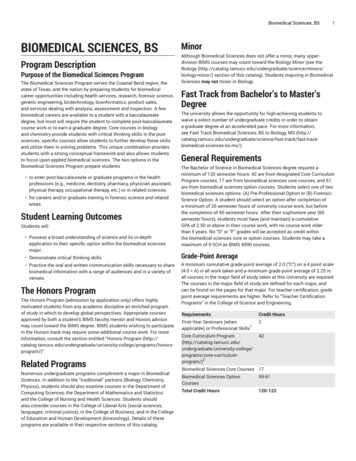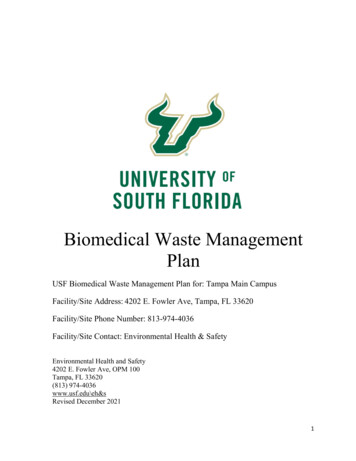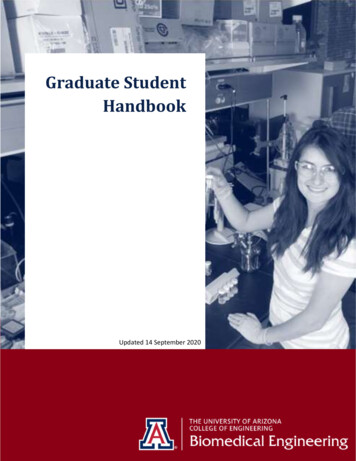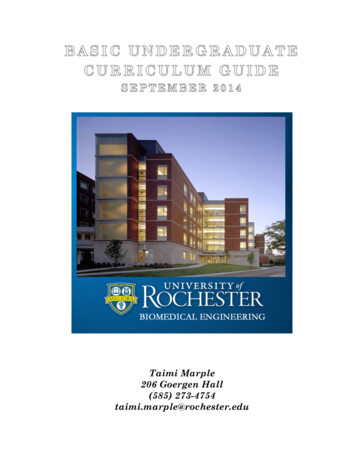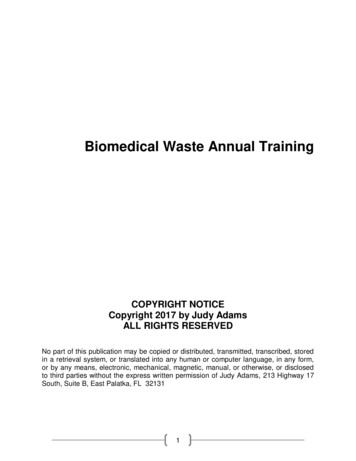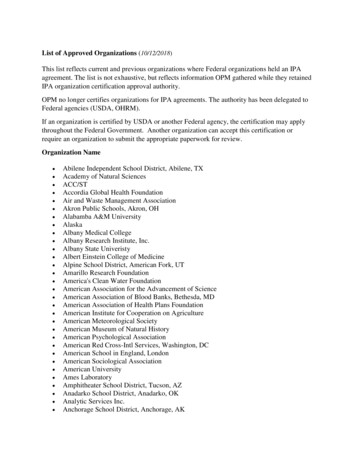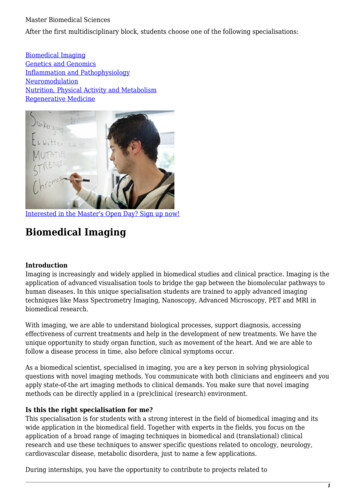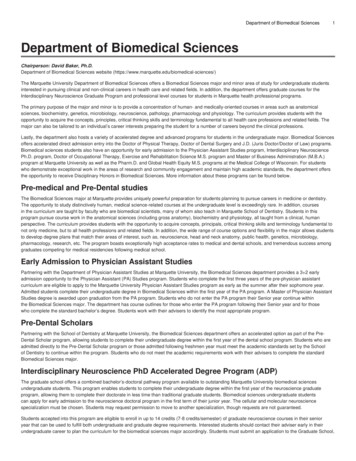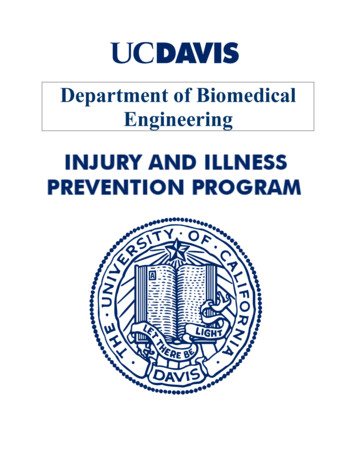
Transcription
Department of BiomedicalEngineering
UC DAVISDepartment of Biomedical EngineeringINJURY AND ILLNESS PREVENTION PROGRAMThis Injury and Illness Prevention Program has been prepared by the University of California,Department of Biomedical Engineering in accordance with University Policy (UCD Policy& Procedure Manual Section 290-15: Safety Management Program) and California Code ofRegulations Title 8, Section 3203 (8 CCR, Section 3203).2
UC DAVISDepartment of Biomedical EngineeringINJURY AND ILLNESS PREVENTION PROGRAMTABLE OF CONTENTSPrefaceDepartment InformationI.Authorities and Responsible PartiesII.System of CommunicationsIII.System for Assuring Employee Compliance with Safe Work PracticesIV.Hazard Identification, Evaluation, and InspectionV.Accident InvestigationVI.Hazard CorrectionVII.Health and Safety TrainingVIII. Recordkeeping and DocumentationIX.ResourcesAPPENDICESA.Hazard Alert/Correction FormB.Job Safety AnalysesC.Worksite Inspection FormsD.Injury and Illness Investigation FormE.Safety Training Attendance Record3
Department InformationDepartment Name: Biomedical EngineeringDepartment Director: Alyssa PanitchAddress: 451 E. Health Sciences Drive GBSF, Room 2303 University of California DavisCalifornia 95616Telephone Number: 530-752-1033Buildings Occupied by Department1. Building:Genome and Biomedical Sciences FacilityUnit(s):1st, 2nd and 3rd FloorContact:Phone:Rebecca Robinson(530) 754-57202. Building:Contact:Phone:3. Building:Contact:Phone:Ghausi HallRebecca Robinson(530) 754-5720Tupper HallRebecca Robinson(530) 754-5720***Modify and expend if needed***4
I.Authorities and Responsible PartiesThe authority and responsibility for the implementation and maintenance of the Injury and IllnessPrevention Program (IIPP) is in accordance with University Policy (UCD Policy & Procedure ManualSection 290-15: Safety Management Program) and California Code of Regulations (8 CCR, Section 3203)and is held by the following individuals:1. Name: Alyssa PanitchTitle: Edward Teller Professor - Department ChairAuthority: Authority and responsibility for ensuring implementation of this IIPPSignature:Date: December 15, 20162. Name: Eduardo SilvaTitle: Chair of Departmental Safety CommitteeAuthority: Department designated authority for implementation of this IIPPSignature:Date: December 15, 2016All Principal Investigators and supervisors are responsible for the implementation and enforcement of thisIIPP in their areas of responsibility in accordance with University Policy (UCD Policy & ProcedureManual Section 290-15: Safety Management Program).Annual Review DocumentationResponsible/Designated AuthorityDateChair of Departmental Safety CommitteeDecember 19, 20165
6
II.System of Communications1. Effective communications with Department of Biomedical Engineering employees have beenestablished using the following methods:Standard Operating Procedures ManualMaterial Safety Data SheetsMonthly departmental operations meetingsInternal media (department intranet)EH&S Safety NetsTraining videosSafety NewsletterHandoutsBuilding Evacuation PlanE-mailPosters and warning labelsJob Safety Analysis – Initial HireJob Safety Analysis – Annual ReviewOther (list): Departmental Faculty meetings, regular staff meetings and research groupmeetings for each faculty member2. Employees are encouraged to report any potential health and safety hazard that may exist in theworkplace. Hazard Alert/Correction Forms (Appendix A) are available to employees for thispurpose. Forms are to be placed in the Safety Coordinator’s departmental mail box. Employeeshave the option to remain anonymous when making a report.3. Employees have been advised of adherence to safe work practices and the proper use of requiredpersonal protective equipment. Conformance will be reinforced by discipline for non-compliancein accordance with University policy (UC Davis Personnel Policies for Staff Members- Section62, Corrective Action).7
III. System for Assuring Employee Compliance with Safe Work PracticesEmployees have been advised of adherence to safe work practices and the proper use of required personalprotective equipment. Conformance will be reinforced by discipline for non-compliance in accordancewith University policy (UC Davis Personnel Policies for Staff Members- Section 62, Corrective Action).The following methods are used to reinforce conformance with this program:1. Distribution of Policies2. Training Programs3. Safety Performance EvaluationsPerformance evaluations at all levels must include an assessment of the individual's commitmentto and performance of the accident prevention requirements of his/her position. The following areexamples of factors considered when evaluating an employee's safety performance. Adherence to defined safety practices.Use of provided safety equipment.Reporting unsafe acts, conditions, and equipment.Offering suggestions for solutions to safety problems.Planning work to include checking safety of equipment and procedures before starting.Early reporting of illness or injury that may arise as a result of the job.Providing support to safety programs.4. Statement of non-compliance will be placed in performance evaluations if employee neglects tofollow proper safety procedures, and documented records are on file that clearly indicate trainingwas provided for the specific topic, and that the employee understood the training and potentialhazards.5. Corrective action for non-compliance will take place when documentation exists that propertraining was provided, the employee understood the training, and the employee knowinglyneglected to follow proper safety procedures. Corrective action includes, but is not limited to, thefollowing: Letter of Warning, Suspension, or Dismissal.8
IV. Hazard Identification, Evaluation, and InspectionJob Hazard Analyses and worksite inspections have been established to identify and evaluate occupationalsafety and health hazards.1. Job Safety Analysis:Job Safety Analysis (JSA) identifies and evaluates employee work functions, potential health orinjury hazards, and specifies appropriate safe practices, personal protective equipment, andtools/equipment. JSA’s can be completed for worksites, an individual employee’s job description,or a class of employees’ job description. Completed JSA’s are located in Appendix B.The following resources are available for assistance in completing JSA’s: Laboratory personnel, please refer to the Laboratory Hazard Assessment ToolNon-Laboratory personnel, please refer to the JSA/PPE Certification Forms(Example JSAs are located in Appendix B1 and Appendix B2 of this template)2. Worksite InspectionsWorksite inspections are conducted to identify and evaluate potential hazards. Types of worksiteinspections include both periodic scheduled worksite inspections as well as those required foraccident investigations, injury and illness cases, and unusual occurrences. Inspections areconducted at the following worksites:1)Location:Frequency:Responsible Person:Records Location:2)Location:Frequency:Responsible Person:Records Location:Genome and Biomedical Sciences FacilityAnnualDiane Hoffmann (Safety Coordinator(s) or liaison(s))GBSF, Room 2303Worksite Inspection Forms are located in Appendix C (C1 - General Office and C2 - Laboratory).(Example Worksite Inspection Forms are located in Appendix C of this template (C1 - General Office andC2 - Laboratory).9
V.Accident InvestigationUniversity Policy requires that work-related injuries and illnesses be reported to Workers’ Compensationwithin 24 hours of occurrence and state regulation requires all accidents be investigated.Department of Biomedical Engineering employees will immediately notify their supervisor whenoccupationally-related injuries and illnesses occur, or when employees first become aware of suchproblems.1. Supervisors will investigate all accidents, injuries, occupational illnesses, and near-miss incidents toidentify the causal factors or attendant hazards. Appropriate repairs or procedural changes will beimplemented promptly to mitigate the hazards implicated in these events. Proper injury reportingprocedures can be found at ryReporting.The Injury and Illness Investigation Form (Appendix D) shall be completed to record pertinentinformation and a copy retained to serve as documentation. It can be completed by either thesupervisor or the Department Safety Coordinator.3. Note: Serious occupational injuries, illnesses, or exposures must be reported to Cal/OSHA by anEH&S representative within eight hours after they have become known to the supervisor. Theseinclude injuries/illnesses/exposures that cause permanent disfigurement or require hospitalization fora period in excess of 24 hours. Please refer to EH&S SafetyNet #121 for OSHA notificationinstructions.10
VI. Hazard CorrectionHazards discovered either as a result of a scheduled periodic inspection or during normal operations mustbe corrected by the supervisor in control of the work area, or by cooperation between the department incontrol of the work area and the supervisor of the employees working in that area. Supervisors of affectedemployees are expected to correct unsafe conditions as quickly as possible after discovery of a hazard,based on the severity of the hazard.Specific procedures that can be used to correct hazards include, but are not limited to, the following: Tagging unsafe equipment “Do Not Use Until Repaired,” and providing a list of alternatives foremployees to use until the equipment is repaired. Stopping unsafe work practices and providing retraining on proper procedures before work resumes. Reinforcing and explaining the need for proper personal protective equipment and ensuring itsavailability. Barricading areas that have chemical spills or other hazards and reporting the hazardous conditions toappropriate parties.Supervisors should use the Hazard Alert/Correction Report (Appendix A) to document correctiveactions, including projected and actual completion dates.If an imminent hazard exists, work in the area must cease, and the appropriate supervisor must be contactedimmediately. If the hazard cannot be immediately corrected without endangering employees or property,all personnel need to leave the area except those qualified and necessary to correct the condition. Thesequalified individuals will be equipped with necessary safeguards before addressing the situation.11
VII. Health and Safety TrainingHealth and safety training, covering both general work practices and job-specific hazard training is theresponsibility of the BME Safety Committee members and immediate Supervisor(s) as applicable to thefollowing criteria:1. Supervisors are provided with training to become familiar with the safety and health hazards towhich employees under their immediate direction and control may be exposed.2. All new employees receive training prior to engaging in responsibilities that pose potentialhazard(s).3. All employees given new job assignments receive training on the hazards of their newresponsibilities prior to actually assuming those responsibilities.4. Training is provided whenever new substances, processes, procedures or equipment (whichrepresent a new hazard) are introduced to the workplace.5. Whenever the employer is made aware of a new or previously unrecognized hazard, training isprovided.The Safety Training Attendance Record form is located in Appendix E.12
VIII.Recordkeeping and DocumentationDocuments related to the IIPP are maintained in/at/on:Genome and Biomedical Sciences Facility (GBSF), Room 2303.The following documents will be maintained within the department’s IIPP Binder for at least the length oftime indicated below:1. Hazard Alert/Correction Forms (Appendix A form).Retain for three (3) years.2. Employee Job Safety Analysis forms (Appendix B form)Retain for the duration of each individual’s employment.3. Worksite Inspection Forms (Appendix C form).Retain for three (3) years.4. Injury and Illness Investigation Forms (Appendix D form).Retain for three (3) years.The following documents will be maintained within the department’s IIPP Training Records Binder for atleast the length of time indicated below:1. Employee Safety Training Attendance Records (Appendix E form).Retain for three (3) years.13
IX.Resources1. UC Office of the President: Management of Health, Safety and the Environment, 10/28/052. UC Davis Policy and Procedure Manual, Section 290-15, Safety Management Program3. California Code of Regulations Title 8, Section 3203, (8CCR §3203), Injury and Illness PreventionProgram4. Personnel Policies for Staff Members, Corrective Action, UC PPSM 625. UC Davis Environmental Health & Safety Safety Services Website EH&S SafetyNets Safety Data Sheets14
HAZARD ALERT / CORRECTION FORMAlert Identification No.Department:I. Unsafe Condition or HazardName: (optional)Job:Title: (optional)Location of Hazard:Building:Floor:Room:Date and time the condition or hazard was observed:Description of unsafe condition or hazard:What changes would you recommend to correct the condition or hazard?Employee Signature: (optional)Date:II. Management/Safety Committee InvestigationName of person investigating unsafe condition or hazard:Results of investigation (What was found? Was condition unsafe or a hazard?): (Attach additionalsheets if necessary.)Proposed action to be taken to correct hazard or unsafe condition: (Complete and attach a HazardCorrection Report, IIPP Appendix E)Signature of Investigating Party:Date:IIPP-Appendix A Completed copies of this form should be routed to the appropriate supervisor and departmentSafety Coordinator, and must be maintained in department files for at least three years.January 2016
HAZARD ALERT / CORRECTION REPORTAlert Identification No.Department:This form should be used in conjunction with the “Hazard Alert Form” (IIPP Appendix A), asappropriate, to track the correction of identified hazards.All hazards should be corrected as soon as possible, based on the severity of the hazard. If a seriousimminent hazard cannot be immediately corrected, evacuate personnel from the area and restrict accessuntil the hazard can be addressed.Supervisor/Safety Coordinator Name:Telephone:Supervisor/Safety Coordinator Signature:Date:Description andLocation of UnsafeConditionIIPP–Appendix AJanuary 2016DateDiscoveredRequired Action andResponsible PartyCompletion DateProjectedActualCompleted copies of this form should be routed to the department Safety Coordinator and kept indepartment files for at least three years.
Example Job Safety AnalysisDepartment:Section:NameJob FunctionEnvironmental Health & SafetyHealth & SafetySignatureDatePotential Health or Injury HazardIIPP-Appendix B1January 20161 of 3Safe Practice, Apparel, or Equipment
Inspection and auditing ofExposure to chemicals via inhalation, contact, ingestion orlaboratories containing chemicals. injection.Avoid all unnecessary exposures. Reduce exposures thatcannot be avoided by minimizing exposure duration andconcentration. Proper selection and use of personalprotective equipment including gloves, protective eyewear,lab coats, and in some instances respiratory protection.Implementation of proper personal hygiene habits,including washing hands and face before eating andsmoking. All personnel to receive on the job and classroomtraining including Chemical Laboratory Safety, HazardousWaste Management and Minimization Training and otherapplicable courses during the first 6 months of employment.Inspection and auditing ofExposure to radiological agents via inhalation, contact,Avoid all unnecessary exposures. Adhere to radiologicallaboratories containingingestion or injection.material handling procedures including limiting exposuresradiological materials.through combination of minimizing time, maximizingdistances and use of appropriate shielding. Proper selectionand use of personal protective equipment including gloves,protective eyewear, lab coats, and in some instancesrespiratory protection Implementation of proper personalhygiene habits, including washing hands and face beforeeating and smoking. Participation in radiologicalmonitoring program including dosimetry. All personnel toreceive on the job and classroom training includingRadiation Safety and other applicable courses during theInspection and auditing ofExposure to biological agents via inhalation, contact,Avoid unnecessary exposures. Proper selection and use oflaboratories containing biological ingestion or injection.personal protective equipment including gloves, protectiveeyewear, lab coats, and in some instances respiratorymaterials.protection. Proper adherence to blood borne pathogenhandling protocols. Implementation of proper personalhygiene habits, including washing hands and face beforeeating and smoking. Voluntary participation in Hepatitis Bvaccination program. Proper adherence to biological wastehandling procedures. All personnel to attend EH&S Bloodborne Pathogen Program training during the first 6 monthsof employment. Participation in Facilities- specific medicalInspection and auditing ofInjury from physical hazards including high voltage, lasers Avoid unnecessary exposures. Proper selection and use ofpersonal protective equipment including gloves, protectivelaboratories, shops and spacesand ultraviolet light, compressed gases and liquids,containing physical hazards.cryogenic materials, and specialized equipment as well as eyewear and specialized equipment. Employees are not toenter restricted areas unless accompanied by a properlyfalling objects.trained individual familiar with the hazards of the area.Employees are not to operate specialized equipment withoutproper training and documentation. Watch for overheadhazards and wear head protection if needed. Personnelauditing or routinely entering areas where lasers are usedwill receive laser safety training within 6 months ofJob FunctionPotential Health or Injury HazardInspection and auditing oflaboratories and animal housingfacilities containing animals.Safe Practice, Apparel, or EquipmentExposure to animals and animal allergies via inhalation and Avoid unnecessary exposures. Proper selection and use ofpersonal protective equipment including gloves, protectivecontacteyewear, lab coats, and in some instances respiratoryprotection. Proper adherence to animal care and useprotocols. Implementation of proper personal hygienehabits, including washing hands and face before eating andsmoking. Participation in the occupational health programfor animal workers. All personnel to attend the IACUCAnimal Care and Use 101 training during the first 6 monthsof employment. Participation in Facilities- specific medicalHandling and moving heavy items Ergonomic hazards including heavy lifting, repetitiveGet help with all loads that cannot be safely lifted by oneand equipment.motions, awkward motions, crushing or pinching injuriesperson. Use mechanical means to lift and move heavyetc.items, push carts and dolly rather than pull, attend backsafety class, employ proper lifting techniques at all times.Set up work operations as ergonomically safe as practical.Wear proper hand and foot protection to protect againsthii hi i j iIIPP-Appendix B1January 20162 of 3
General office workBack strain, eyestrain, repetitive motion injury. Physicalinjuries due to slips, trips and falls, and falling objects.Electrical hazards. Physical injuries due to fires,earthquakes, bomb threats and workplace violence.Operation of motor vehiclesMotor vehicle accidents involving personal injury, orproperty damageExposure to noise hazardsHearing loss due to noise exposureIIPP-Appendix B1January 20163 of 3Ensure that workstations are ergonomically correct. Keepfloors clear of debris and liquid spills. Keep furniture,boxes, etc. from blocking doorways, halls and walkingspace. Do not stand on chairs of any kind, use proper footstools or ladders. Do not store heavy objects overhead. Donot top load filing cabinets, fill bottom to top. Do not openmore than one file drawer at a time. Brace tall bookcasesand file cabinets to walls. Provide one-inch lip on shelves.Do not use extension cords in lieu of permanent wiring.Ensure that high wattage appliances do not overloadcircuits. Use GFCIs in receptacles in potentially wet areas.Replace frayed or damaged electrical cords. Ensure thatelectrical cords are not damaged by being wedged againstfurniture or pinched in doors. Attend emergency action andfire prevention plan training including emergency escapedrillsAll drivers of University vehicles must attend the DriverSafety Awareness Course offered by Fleet Services andpossess a valid California drivers license. Hazardousmaterials may not be transported in personally ownedvehiclesVoluntarily participate in the Hearing ConservationProgram. Use hearing protection as required.
University of California, DavisLaboratory Self-Inspection ChecklistPrincipal Investigator/Laboratory Supervisor:Laboratories Reviewed:Date:Reviewer:I.Revised 1/2015SAFETY PROGRAM ADMINISTRATONA. Chemical Hygiene PlanYesNoN/AYesNoN/AYesNoN/AYesNoN/AYesNoN/A1. Does the laboratory have access to the campus-wideChemical Hygiene Plan and all of the requiredelements?2. Are there any operations that require prior approvalbefore beginning (e.g., Radiation Safety, Bio-safetycommittee)?B. Illness and Injury Prevention Plan1. Does laboratory have access to Department IIPP andhas it been reviewed in past year?2. Is there documentation that all laboratory personnelhave trained on IIPP?C. Standard Operating Procedures (SOP’s)1. Are there written SOP’s covering the laboratoryprocesses and hazardous chemicals referenced in Title8 (i.e., acutely toxic substances, reproductive toxins,and regulated carcinogens)?2. Are there exemptions to the written SOPs and arethese documented?3. Training of laboratory personnel documented.4. Required specialized training complete anddocumented.5. Training is current with Chemical Hygiene Plan.6. Training is complete on Hazardous waste management.7. Training is complete on Blood borne Pathogenrequirements.II.HAZARDOUS MATERIALS1. Laboratory doors are labeled with emergency contactnotification names & numbers, hazards present &necessary precautions.2. Labels are clean and intact on all chemical containers.3. Chemical containers are clearly identified with contentsand hazards.4. Containers with non-hazardous substances (i.e., water)clearly labeled to avoid confusion.A. Chemical ControlsNotes:Pg. 1
1. Chemicals are not stored on laboratory benches inexcessive quantities.2. Expired or chemicals not used (for more than one year)are disposed of as hazardous waste.3. Secondary containment is provided for strong acids andstrong bases.4. Incompatible chemicals are segregated and stored withcompatible hazard classes.5. All chemical containers are closed, except whenactively adding or removing materials from them (i.e.,no open funnels left in container).6. Containers of peroxide-forming chemicals are datedupon receipt and disposed of as hazardous wastewithin one year of receipt.7. Safety Data Sheets (SDS) and laboratory chemicalinventory are up-to-date and readily available.8. Chemicals (liquids) are stored below eye level and notdirectly on the floor, unless in secondary containment.9. Dedicated chemical storage (cabinets, refrigerators,freezers) clearly labeled with contents and hazardwarnings.B. Flammable & Combustible LiquidsYesNoN/AYesNoN/AYesNoN/A1. Flammable liquids stored in 1-gallon or smallercontainers or kept in 2-gallon or smaller safety cans.2. Flammable liquids (including flammable liquid waste)stored outside of a storage cabinet does not exceed 10gallons.3. If more than 10 gallons of flammable liquids arepresent does the laboratory have an approvedflammable storage cabinet?4. Flammable liquids, stored in flammable storagecabinets limited to 60 gallons per fire rated area.5. Flammable liquids requiring reduced temperaturestored in flammable-rated refrigerator/freezer.C. Particularly Hazardous Substances1. Have all particularly hazardous substances beenidentified?2. Designated area(s) for acutely toxic materials,reproductive toxins and/or carcinogens clearly marked.3. Are all users adequately trained? Documentationavailable?4. All necessary PPE (personal protective equipment)available and used as needed.D. Radioactive Materials1. Stock materials of radioactive materials are securedagainst unauthorized removal?2. Do personnel wear lab coats and gloves when handlingradioactive materials? If assigned dosimeters, are theywearing them?Notes:Pg. 2
3. Are all radioactive materials registered with the EH&SHealth Physics Program?4. Radioactive Waste – Properly labeled, segregated, andshielded?III.CHEMICAL WASTEA. StorageYesNoN/AYesNoN/AYesNoN/AYesNoN/AYesNoN/A1. Are chemical waste containers properly segregated,sealed with tight-fitting caps and stored with EH&SHazardous Waste Labels attached?2. All hazardous chemical waste is arranged to be pickedup by EH&S — not drain disposed or evaporated.3. Hazardous chemical waste has been accumulating forless than 270 days. Extremely hazardous waste hasbeen accumulating less than 90 days.4. All hazardous chemical waste is secondary contained.5. Training for personnel handling hazardous waste isdocumented?6. EH&S is called for waste pick up when containers arefull (90% capacity or full line) or have reached theiraccumulation date threshold.7. Waste containers sturdy, compatible with the waste,routinely checked for leaks and kept closed when notactively being filled.B. Labeling1. All hazardous waste containers have the proper labelswith contents and accumulation start date.2. The hazardous waste accumulation area is clean withwaste containers clearly marked.IV.BIOHAZARDOUS WASTEA. Storage1. Solid bio hazardous waste is bagged in redpolyethylene bags as per the Medical WasteManagement Plan.2. Bio hazardous liquid waste is managed per the MedicalWaste Management Plan.3. Sharps stored in puncture-proof containers and labeledappropriately, not past fill line.B. Labeling1. Secondary containers for laboratory medical wastestorage or transport labeled with the internationalbiohazard symbol and the word “Biohazard.”V.PERSONAL HEALTH AND SAFETYA. Food and Drink1. Sinks labeled “Industrial Water – Do Not Drink”.2. Food and drink is not permitted in laboratories.3. Food and drink is stored only in refrigerators/freezersdedicated and labeled “for food only”.Notes:Pg. 3
B. Standard . Employees wash areas of exposed skin prior to leavingthe laboratory.2. Sink is available and hands washed after removinggloves and before leaving laboratory.3. Cosmetic applications, taking medication, touchingeyes, nose or mouth avoided in laboratory.VI.HEALTH AND SAFETY EQUIPMENTA. Safety Showers and Eye Washes1. Approved safety showers and eye washes providedwithin 10 seconds travel time from the work area forimmediate use, with no barriers (i.e. doors) for use orstorage of corrosives.2. All eyewashes and showers have unobstructed access.3. Units inspected and activated monthly. Annuallycertification by Facilities Management for properfunctioning.4. Sign indicating location of safety shower and eye washunobstructed.B. Personal Protective Equipment1. Has the correct PPE been selected based on a hazardassessment or SDS recommendation?2. PPE required for laboratory work: ( ) Lab Coats,( ) Safety glasses with side shields/goggles,() Hearing protection, ( ) Face Shield, ( ) Properfoot-wear, ( ) Gloves, ( ) Aprons3. All necessary equipment is available, in good condition,and properly used.C. Laboratory Fume Hoods1. Storage inside of hood is kept to a minimum.2. Equipment in use does not interfere with properfunctioning of the hood.3. All work is done at least 6 inches inside hood.4. Front sash is lowered when hood is not in use.5. Certified annually by Facilities Management, semiannually for Title 8 §5209 “listed” Carcinogens.6. Hood has continuous flow monitor.7. The back ventilation slot is not obstructed.8. Drains are protected from hazardous materialsentering.D. Biological Safety Cabinet1. Certified within the last year.2. Proper type of hood for work being conducted.3. Equipment is properly labeled for the hazard present(radiation, UV,), Manufacturer approved for hazard.4. Hood ducted per manufacturer and ASHRAErequirements and meets the bio-safety specifications.Notes:Pg. 4
E. Compressed Gas CylindersYesNoN/AYesNoN/AYesNoN/AYesNoN/A1. Cylinders stored in well protected, well vented and drylocations away from combustible materials.2. Flammable gases stored away from oxidizers.3. Cylinders are secured to a rigid structural componentof the building with non-flammable restraints located1/3 and 2/3 (preferred) or ½ the height of thecylinder.4. Protective caps in place while cylinders are in storageand full/empty tags attached.5. Proper regulators are being used and closed whencylinders are not in use.F. Housekeeping & Miscellaneous Laboratory Safety1. Bench tops clean, organized and environs maintainedto eliminate harmful exposures or unsafe conditions.2. Supplies stored at minimum of 24 inches from ceilingand off the floor.3. Vacuum lines equipped with traps designed specificallyto accumulate/filter the hazardous materials beingevacuated.4. All moving machinery (i.e., vacuum pumps) beltsadequately protected by a rigid belt guard or housing.5. All sharps disposed properly.6. The condition of the broken glass box is adequate andplaced out of the way.7. Ceiling tiles present and in good condition.8. Refrigerators/freezers labeled according to use.G. Electrical Safety1. High voltage equipment ( 600V) labeled, groundedand insulated.2. No equipment has damaged or frayed cords.3. Extension cords are not connected together.4. Power strips used only if they are equipped with circuitbreakers.5. All equipment i
III. System for Assuring Employee Compliance with Safe Work Practices IV. Hazard Identification, Evaluation, and Inspection V. Accident Investigation VI. Hazard Correction VII. Health and Safety Training VIII. Recordkeeping and Documentation IX. Resources APPENDICES A. Hazard Alert/Correction Form B. Job Safety Analyses C. Worksite Inspection Forms
